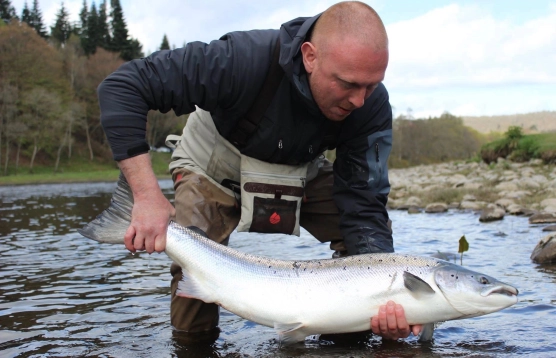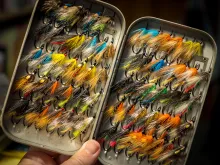The secret behind catching Scottish spring salmon!
The Scottish spring salmon is one of the most sought-after fish amongst the fly fishing fraternity.
These magnificent creatures
are often big in size, and incredibly powerful. They can give any angler a run for their money. The feeling that you get after successfully landing on these stunning fish is truly indescribable, as they can be quite rare. So, what are the best tactics, when chasing early season Scottish spring silver?
The Scottish salmon fishing season begins at different times, depending on the specific river itself. Generally, a few rivers open in January, and by mid-February, all the main salmon rivers have their season underway.
At this time of year, the weather in Scotland can be quite inhospitable. It is often very cold, with strong winds and even frequent snow showers. River levels are usually quite high, and the water is very cold.
You therefore need
to make sure that your is fly is moving through the water column at a decent depth and at the correct speed. This will give you the best chance of making contact with a hard-fighting Scottish spring salmon.
When it comes to fly patterns, there is no need to be subtle in your choice. The fresh springer is usually quite an aggressive creature, and if it sees the fly, it is likely to take it. Indeed, it is often said that a springer is the easiest fish to catch but the most difficult fish to find, and this often rings true.
Therefore, when it comes to choosing a fly pattern, you want to make sure that it is highly visible in the water. So be bold in your fly size and choice, and make sure that the fly is quite bright. If the fly shows up well in the water, there is more chance that the fish will see it. Also, make sure that the fly is big enough. Usually early in the season, tubes flies between one and two inches can be perfect for the job. Salmon flies like the Willie Gunn, Cascade and Posh Tosh are all excellent spring flies and are very successful in Scottish waters.
Samantha Datta
Subtlety in fly choice
is not key, when chasing Scottish springers, but the depth and speed at which the fly moves through the water certainly is. Usually between the months of January and April, the water temperature in our Scottish rivers is quite low. This is often because of melting snow and limited daylight, early in the season.
When the water is cold, you want to get your fly moving close to the riverbed. Most of the fish in the pools, will be lying well down in the water column, close to the bottom. Often, the fish are not willing to move any great distances or come up towards the surface of the water to take a fly in such cold conditions.
There are two ways
in which you can make your fly fish that bit deeper through the water column. Firstly, this can be achieved by altering the fly line that you are using. By using a sink tip or full sinking line, the fly will move through the water at a greater depth and therefore closer to where the fish are likely to be lying.
The second way to make the fly fish deeper is by changing the weight of the fly itself. Tube flies are made from various materials, which differ significantly weight. The body of the tube can be composed of copper, brass or even tungsten. These heavy flies, sink quickly after they hit the water and so get down in the water column quickly. If the water is very high and cold, you may opt for a fast sinking line coupled with a large tungsten tube (the heaviest material tube flies are constructed from) to achieve maximum depth.
So far, we have looked
how to get the fly to fish at an adequate depth. Another factor we need to consider is the speed at which the fly moves through the water. When the water is cold, you want the fly to move through the water as slowly as possible. This gives the fish the maximum amount of time to see the fly. Also, when the water is cold, salmon are not keen on chasing flies long distances, so a fly moving at slower speed is more likely to be effective.
If you are allowing the fly to swing around in the current naturally, by using a heavier fly, it will automatically move through the water more slowly. So, a heavy tube fly is perfect for the job.
Another way to slow the fly down, as it swings around in the current is by putting an upstream mend in the fly line. This can be achieved by flicking the tip of the fly rod upstream in circular motion after casting. This creates an upstream belly in the fly line. This will not only slow the fly down, as it swings around in the current, but also give it more of a chance to sink and get to the optimal depth.
So as you can see,
the pattern of the fly is not as important as the speed and depth at which the fly is moving through the water. Generally, you want the fly to be moving as slowly and deeply as possible, especially when the water temperature is low. If you can get both these two parameters right, you then tilt the odds greatly, in your favour of catching the king of fish, a prime Scottish spring salmon.
About Samantha and Sandy Datta
Together, we have over 33 years salmon fishing experience and have fished all over the UK and Ireland.
Sandy Datta together with his wife Samantha are co-founders of Scottish Salmon Fishing Surgery (SSFS). This is Scotland’s first and only online salmon fishing magazine. The magazine has proved to be a great worldwide success and now has readers in over 77 countries. Sandy and Samantha together have over 35 years’ experience, salmon fishing in Scotland.
In addition to this, they also launched a company called Salmon Fishing Holidays Scotland . This company is dedicated to providing bespoke tailor-made salmon fishing holidays in Scotland.
In their spare time, Sandy and Samantha are both very passionate about their salmon fishing. They are never found too far away from the river bank, and they usually have a rod in their hands!
- Log in to post comments










